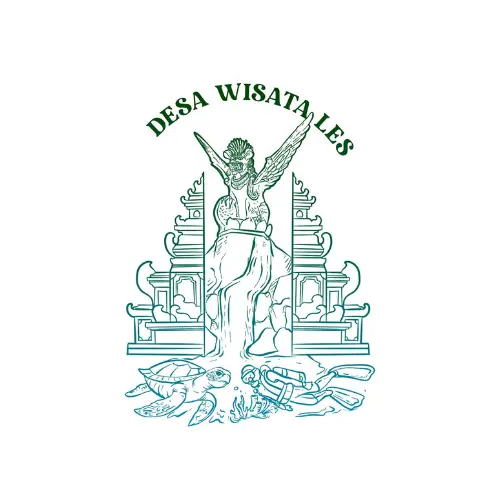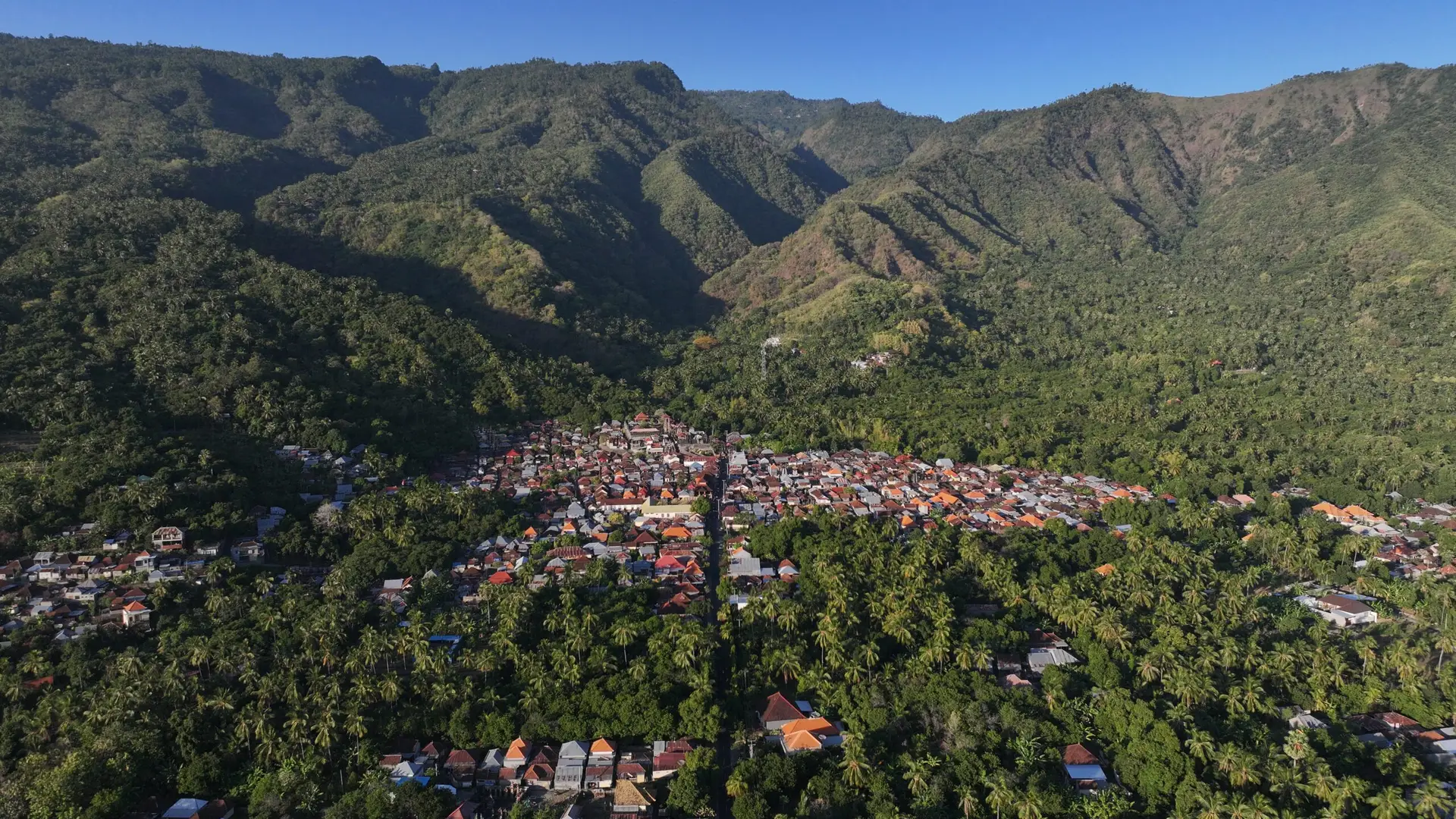Les Tourism Village or Desa Wisata Les is a tourism village with a concept of developing both the coast (Nyegara) and the mountains. In developing tourism activities, Les Tourism Village showcases the natural potential, culture, and local wisdom of the community. With activities that support each other between nature, culture, and the community, a tourism concept is realized where the upstream (mountains) and downstream (sea) become harmonious.
Administratively, Les Village is part of Tejakuka Subdistrict, which covers an area of 97.68 km² and is located on the eastern side of Buleleng Regency. Tejakula Subdistrict is 38 km from the administrative center of Buleleng Regency in the west. This subdistrict has a coastline of 27.23 km. The topography of Tejakula Subdistrict is lowland with an average temperature of 28°C. Tejakula Subdistrict consists of 10 villages, one of which is Les Village, located in the east.
Regarding the origin of the name Desa Les, some say it comes from the word ngenes or mekiles, which means to go from one place to another while hiding. But because it is written in Balinese script, the letter “nga” is replaced with “na kojong,” resulting in the sound Les. Another version says that the village has always been called Les, which means to hide. According to the Kawi dictionary by W.J.S. Purwadarminta, the word “les” means to run or flee. Meanwhile, the word ngenes means (supposedly) to hide.
Les Village is located on the northern coast of the Bali Sea. The administrative boundaries of Les Village are:
- North : North Bali Sea
- South : Kintamani Forest, Bangli
- East : Penuktukan Village
- West : Tejakula Village
BECOMING ONE OF THE OLDEST VILLAGES IN BALI
Les Village is one of the oldest villages in Bali. The name Les is mentioned in the Kintamani E Inscription, which was issued in 1122 Saka (or 1200 AD). Epigraphic and ethnographic data from the classical period between the 9th and 12th centuries in Bali show that there was a dendritic relationship between the villages on the Tejuka coast and the inland region of Kintamani. This relationship, which is clearly mentioned in the inscriptions (Sukawana D and Kintamani E), can also be seen through the connection between the ceremonies at Pura Puncak Penulisan in Sukawana Village, Kintamani.
The ceremony at the temple was conducted by an alliance of 45 people from the Setimanan village group. Twenty-two members were from the Tejakula and Les coasts, while the remaining 23 members were from Sukawana. In Les Village, there is Sanggah Kamulan Dadap Sakti, while in Sukawana, Siakin, Pinggan, Penuktukan, and Sambirenteng villages, there are similar places.
In addition, the Les region and its surroundings are also believed to have been a major port in the past. This evidence is recorded in various inscriptions such as Sawan/Bila A1 from 1945 Saka (1023 AD), the Sembiran A IV inscription from 987 Saka (1065 AD), and the Kintamani E inscription from 1122 Saka (1200 AD).
NYEGARA MOUNTAIN
The landscape of Les Village is quite complete. There is land (pertiwi) in the south and sea (baruna) in the north. This combination makes Les a village with a lot of potential. Les Village covers an area of approximately 769 hectares, including 200 hectares of forest and 135 hectares of coastal area. Most of the Les Village area consists of fields and protected forests. Only four percent of the area is rice fields, while only six percent is residential areas. The Les Village coastline stretches from west to east for two kilometers. The geographical shape of Les Village is a combination of lowlands and highlands. The rocky coastline ranges from small to medium-sized boulders, with gray to black sand—the gray sand is a remnant of the eruption of Mount Agung. Les Village consists of nine banjars (hamlets), namely Kanginan, Butiyang, Panjingan, Tegallinggah, Kawanan, Selonding, Tubuh, Lempedu, and Banjar Panyumbahan.
The coastal community in the Les Village area views the sea as a cosmic order both in the physical (real world) and metaphysical (unseen or supernatural) realms. The sea as a cosmic order in the physical realm is viewed by the local community as part of nature that can be used as a living space, a place to seek their fortune. The fishermen’s view of the sea as a living space can be seen in the expression “uma abiane di pasihe”. On the one hand, this expression implies the strong agrarian culture of the fishing community, as a consequence of the ideology that views rice fields and farmland as an ecology where they carry out their productive activities. This agrarian cultural richness is certainly related to the socio-economic cultural background of the fishing community, which was previously generally made up of rice farming families.
On the other hand, this expression implies a growing awareness among most coastal communities that the scope for making a living is not only in rice fields (uma) and gardens/fields (abian), but also in the sea. Thus, fishing communities have developed a bipolar ideology of life resources. This is in line with the nyegara gunung ideology, which is not only socio-religious in nature but also socio-economic, cultural, and political. Awareness of the sea as a cosmic space with the potential to support the livelihoods of coastal communities has led to an awareness of the importance of maintaining and preserving coastal and marine ecosystems.
THE POTENTIAL OF LES VILLAGE
Les Village has three (3) main coastal resource potentials, namely (1) consumption fisheries or capture fisheries, (2) ornamental fisheries, and (3) marine ecotourism. This is inseparable from the condition of the Les Village fishing area, which is indeed very suitable for ecosystems and capture/consumption fish resources. The capture fisheries area in the coastal waters of Les Village is part of the fisheries management area of North Bali. The types of capture fish or consumption fish found in the coastal waters of Les Village include tuna, salmon, mackerel, squid, and octopus.
Other than consumption fisheries, the waters of Les Village have potential for non- consumption fisheries, namely ornamental reef fish and commercial natural seedlings. The types of ornamental fish found in the sea around Les Village consist of five families, namely: (1) Pomacanthidae family, including purple angelfish (Centropyge argi), BK angelfish (Centropyge bicolor), black angelfish (Centropyge melas), gray angelfish (Curoliki sp); (2) Labridae family, including the striped triggerfish (Bodianus bilunulatus), sea dog (Bodianus sp.), leaf triggerfish (Cheilio enermis), and pearl triggerfish (Coris sp.); (3) Acanthuridae family, including the yellow tang (Acanthurus caerulerus), blue tang (Acanthurus leocostemon), spectacled tang (Acanthurus nigricans), and striped tang (Acanthurus lineatus); (4) Chaetodontidae family, including elephant butterflyfish (Chaetodon lunula), moon butterflyfish (Chaetodon speculum), pyramid butterflyfish (Hemithaurichthyes polylepis); (5) Scorpaenidae family, including the flower scorpionfish (Dendrochirus zebra), elephant scorpionfish (Nemapterois blocellata), biting scorpionfish (Pterois antenata), and radiata scorpionfish (Pterois radiata).
Other than consumption fisheries and non-consumption, another potential resource of Les Village is its biodiversity and coral reef ecosystems. Coral reefs are ecosystems that are extremely important for the sustainability of resources found in coastal and marine areas. They generally grow in tropical regions and have high primary productivity. Meanwhile, on the coast of Les, there are traditional salt fields with excellent quality products.
On the mainland, Les has a waterfall called Yeh Mampeh, which is approximately 20 meters high. Then there is the Bukit Yangudi tracking trail, a place for melukat (ritual cleansing) in Yeh Anakan, where the water flows directly from natural springs.
The palm trees that grow abundantly on the ridges and slopes of the hills make Les a village with promising production of sugar, palm wine, and arrack. There is also a rich variety of culinary delights, two of which are the famous jukut blook and mengguh. Les also offers a variety of seafood dishes, notably through Warung Bali Mula, which has successfully attracted travelers from diverse backgrounds, both domestic and international.
Also, don’t forget the rich cultural heritage, traditions, and arts. Les is quite confident about this. Puppeteers, silver and gold craftsmen, weavers, and carvers are quite prominent in this village. These artists seem to have been born with their talents, without going through any formal education. And look, their works are just as good as those of artists from Ubud and its surroundings.
REFERENCES
Ardika, I Wayan. 1989. Archaeological Excavation at the Sembiran and Pacung Sites, Tejakula District, Buleleng. Denpasar: Universitas Udayana.
Ardika, I Wayan. 2022. Humans and Culture in Bali 2000 Years Ago. Denpasar:Universitas Udayana.
Arta, Ketut Sedana. 2019. Trade in Northern Bali During the Ancient Balinese Kingdom: A Historical-Geographical Perspective. Social Science Journal, Vol. 5, No. 2.
Maryati, T, et al. 2009. Pecalang Segara “Traditional Security Task Force for the Preservation of the Coastal and Marine Environment” (A Study of the Pakraman Community on the North Coast of Bali). UNDIKSHA Singaraja.
Rimayani, Sungkem Putrika. 2015. Coastal Resource Management Based on Local Wisdom of Les Village Community, Tejakula District, Bali. Bachelor Thesis, Universitas Brawijaya.


Leave a Reply